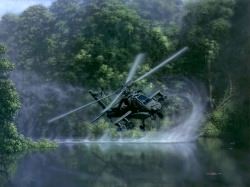| Helo Sim Flight Models
by Zero G |
||||
|
Introduction Recently Eric Marlow was conversing with Zero_G on the topic of helo sims in the industry, in particular focusing on the flight model (FM). Here is part of that conversation. Watch for more from Zero_G soon! Current Helo Sims:
Coming Soon:
By leaving out many important FM aspects developers miss a big part of that system. Here are my own top ten: 1) Torque effects. This can be the nasty little thing that bites you in the ass. To run the pedals in a helo is constant work when at slow speed and somthing that needs attention at higher speeds. They even need to advance from Apache Havoc the more collective you pull the more torque you have thus the more pedal you need. Quick pulls of the collective can be a terrible problem: more so with a heavy load on the helo. This needs to be modeled. When I was training I was learning how to come out of translation to a hover. I was coming in high to my spot of landing so I thought I would just let the collective down and fall a little faster. My big concern was not getting into a vortex ring state so I watched my rate of descent very closely. Once you come out of translation the helicopter needs more power to stay up. I never caught the need to pull collective for a moment till I was droping quite fast. Instinct tells you to pull collective, lots of it and fast, so I did. |
 That is why they have an instructor in the helo with you, the helicopter snapped around so fast that I just froze for 1-2 seconds. That would have been enough for me to get into an almost unrecoverable spin [for someone with low hours] Let's just say I owe my instructor a big one, he reacted very fast to stop the problem then right away made me finish my landing. One quick practical lesson on torque and all the class room speechs about it made perfect sense.) This leads us to #2. 2) Translation. Translational lift is what happens when a helo gets an airspeed of 15-20 mph.The rotor becomes much more effective since it is getting clean air to cut.This makes the helo do a strange kick backwards when moving forward into translation and the helo will want to start to climb. It also makes you need more power when slowing to a hover this addition of power along with the reduced airflow past the helicopters body is why you need to add pedal when slowing and hovering.This is very important to flying but it my be out of reach with todays computer power. 3) Weight. The Apache is rated to carry just over 6000 pounds. This doesn't mean that with a full load like this it can just up and take off. Most helicopters when loaded to full weight must either do a rolling take off much like a plane (the Hind does this for most missions) or they push forward and stay under 6-8 inches in the air until they get translational lift. If a helicopter is is allowed to slow down while it is loaded heavily it can do a thing called settling with power. This just means that you are too heavy for the helo to hold itself up and it will sink untill it hits something. This causes many helo crashes when combined with wind. When a pilot is looking for a place to set down, or in the case of a gunship a place to stop and peek over a hill, if all the pilot watches is his\her speed and not airspeed they can get below translation when they have a tail wind. The same happens to pilots moving slowly who then turn down wind. If the wind speed takes their airspeed below translation they can sink into the trees/buildings/rocks below. Doing a proper weight model is very important. Go to Part II
|
|||
|
Copyright © 1997 - 2000 COMBATSIM.COM, INC. All Rights Reserved. Last Updated May 5th, 1999 |
||||
